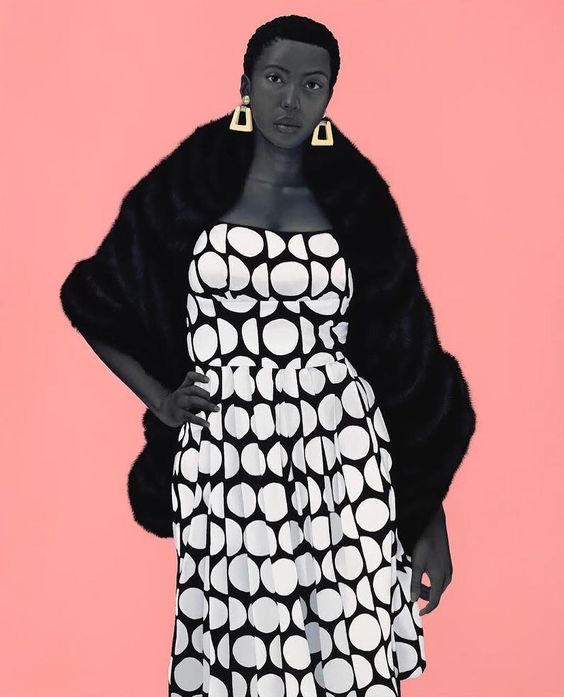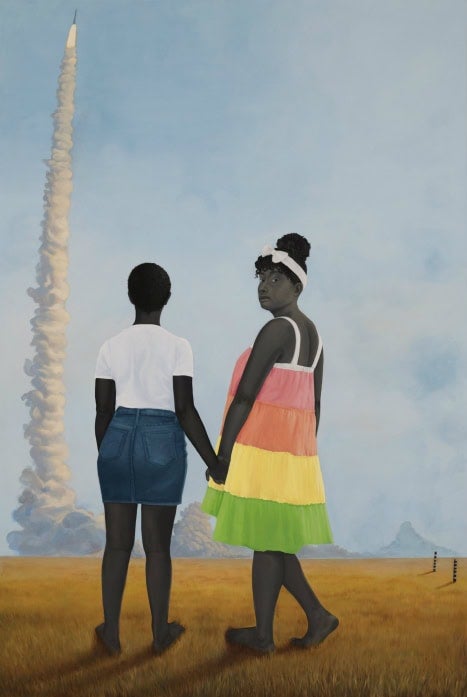Painter Amy Sherald’s eponymous solo exhibition at the Spelman College Museum of Fine Art this spring has marked a sort of homecoming for the artist, who completed her undergraduate studies at Clark Atlanta University and studied painting with Arturo Lindsay at Spelman. Burnaway asked Dr. Michelle Hite, professor of English at Spelman College, and TK Smith, Tina Dunkley Curatorial Fellow at the Clark Atlanta University Art Museum, for close readings of two recently completed paintings in the exhibition.

What shapes what we see? How we see joy, for example, or fulfillment? Amy Sherald’s Mama has made the bread. (How things are measured) (2018) raises these questions through the presentation of a Black woman adorned in shapes, draped in textured curves, issuing forth through folds and pleats. Contrary to a presumed familiarity with Black womanhood, this painting speaks through shapes to showcase the person bringing them forth as the bearer of a misrecognized public persona. The painting comments on the general misapprehension of Black women’s subjectivity and lived experience and presents this critique through its rendering of the woman’s sartorial style. Thus, this misunderstanding occurs in the culture like the circles of the woman’s dress that from a distance appear to be semi-circles. The painting’s title enables the pleats and folds to emerge, and with them, a clearer and more accurate way of regarding Black life.
The derivation of the painting’s title offers increments of a metric for considering Black life anew. Lucille Clifton’s poem “Good Times” includes the direct reference in the first part of Sherald’s title, and an interpretation of the poem’s entirety might explain the parenthetical remarks constituting the second half of the title absent from Clifton’s poem: “How things are measured.” “Good times,” then, describes an occasion when bills are paid and fortune runs concurrent with at least some relief from the general strain of home economics. In both Clifton’s poem and Sherald’s citation, “My Mama has made bread” could literally refer to the baked good or, in a vernacular sense, to the woman as a wage earner. Thus, family, money, food, libations, dancing and singing together mark the presence of “good times” as well as the continuity of that recognition for poet and painter alike.
In using Clifton’s words as her painting’s title, Sherald unites the creative work of two migrants to Baltimore, Maryland, in acknowledgment of their common social and familial witness. In this context, the range of materials in the painting—the fur, metal, and cloth—become emblematic of the flourishing each woman witnessed within Black experience. Here, sartorial style reifies the seen capacity for beauty and joy to emerge where it had not been intended; for the shapes and curves in the fabrics and the gestures bearing them to recall the celebration marked through a human capacity for creative expression, and to recall that revelry began with a sigh of relief.
Retelling the life-world of Black people in the way of Mama has made the bread. (How things are measured) requires a vocabulary rooted in the most basic terms. So, in using the colors of maximum contrast, black and white, and set against the fashionable pantone of “living coral,” this painting tells the story of its subject’s capacity to breathe.
— Dr. Michelle Hite

Of all my speculations concerning Amy Sherald’s Planes, rockets, and the space in between (2018), the one thing I am certain of is that the painting marks a place of departure in her practice. I am deliberate when using the term departure because it asserts movement forward while bearing the all the weight associated with the unknown. This is a transitional work for the artist and, in that process, there is a sense of apprehensiveness: fear of not knowing, fear of loss.
The obvious departure is into a landscape of Sherald’s own construction. Instead of her vivid two-dimensional, singularly colored backgrounds, she provides viewers with a constructed world. With that world comes new narratives and symbols formed in ways viewers are not accustomed to in her paintings. Sherald places two barefoot figures in a plane of golden grass. They face the sun as their shadows stretch down toward the bottom left of the canvas. A range of hazy mountains border the horizon, opening to a distant blue sky, thick with powdery white clouds. Interrupting her landscape, the urgent propelling of a distant rocket leaves a trail of exhaust standing like a column holding up the sky. What does it mean for Sherald to construct narratives beyond the bodies of her figures? What does the physical world look like shaped by Sherald’s eye? What are the rules in this new world? If, in her portraits, subjects could evade the racialization of their skin through her signature grayscale style, in her landscapes, could her subjects fly?
Sherald’s positioning of the figures also touches new ground. The majority of her portraits feature subjects that unflinchingly return the gaze of the viewer. They are positioned facing out, sometimes to the side, but usually their eyes pierce through the canvas. In Planes, both figures’ bodies are turned away from the viewer. The left figure is completely turned away, stolid in her position, while the right figure glances back over her shoulder. Her foot is upturned, her body communicating slight hesitation. The figures are facing into her landscape, into Sherald’s new world, visually embarking with her.
Departure also captures the tone of this work. It doesn’t just depict movement—it evokes the emotions and anxieties that come with change. The facial expression of the right figure, glancing backwards, seems to ask the viewer, “Are you coming with us?” The positioning of the figures strikes me as a reference to the Twi symbol of Sankofa. Their clasped hands cement the central bond of the heart-like symbol, reassuring viewers that Sherald is embracing the future and creating something new but still carries with her the knowledge of her past.
The title of the work, Planes, rockets, and the space in between, poetically asserts movement—not just forward, but up. This could be a signal to Sherald’s viewers that her practice is departing from the confines of this atmosphere we have created for her. She has abandoned the limitations of a monochromatic plane for the upward trajectory of a rocket. We need not be concerned with what Sherald typically does but should prepare ourselves for what she’s about to do. This particular painting may just be the space in between.
— TK Smith
Amy Sherald is on view at the Spelman College Museum of Fine Art in Atlanta through May 18.




